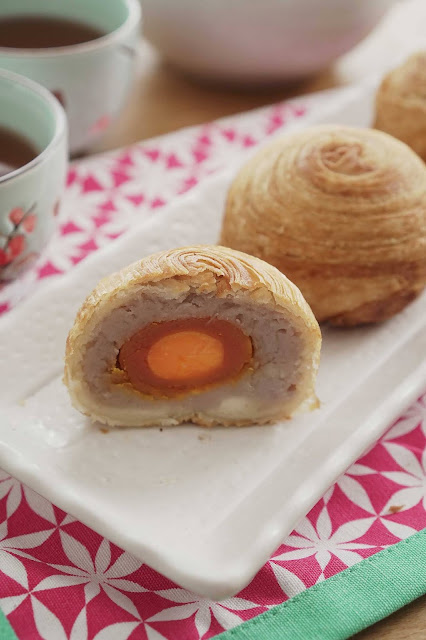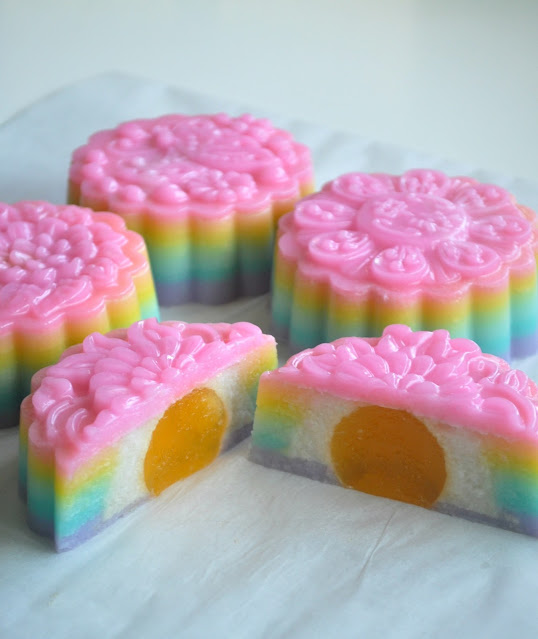I had many different mooncakes this Mid-Autumn Festival, although I finished them before I got the idea of writing a blog post about them. Usually, mooncakes have egg yolk inside, which isn't really my type of food. Luckily, my son likes the salty yolk, so I can eat the rest with red bean or mung bean paste.
This year was my first time trying Hong Kong style mooncakes, and I'm in love with them! Not only do they taste good on the outside, but they also have many non-traditional fillings. We had some with banana, strawberry, and pear flavors!
What is a moon cake?
A mooncake (月餅) is a bakery product traditionally eaten during the Mid-Autumn Festival (中秋節) in parts of Asian countries. The festival is about lunar appreciation and moon watching, and mooncakes are regarded as a delicacy. Mooncakes are offered between friends or family while celebrating the festival.
Typical mooncakes are round pastries with a rich and thick filling, usually made from red bean paste or lotus seed paste, surrounded by a thin 2–3 mm crust. They may also contain yolks from salted duck eggs, symbolizing the full moon. Traditional mooncakes have imprints on top consisting of the Chinese characters for "longevity" or "harmony," as well as the name of the bakery and the filling inside. Additional decorations may include imprints of the Moon, Lady Chang'e on the Moon, flowers, vines, or a rabbit (symbol of the Moon).
Traditional mooncake fillings
Lotus seed paste (蓮蓉)
Considered by some to be the original and most luxurious mooncake filling. White lotus paste is even more premium. Sometimes, white kidney bean paste is used as a filler due to the high price of lotus paste.
Sweet bean paste (豆沙)
There are various pastes commonly used as fillings in Chinese desserts. While red bean paste made from azuki beans is the most common worldwide, regional preferences exist for bean paste made from mung beans or black beans.
Jujube paste (棗泥)
This sweet paste is made from ripe jujube (date) fruits. It has a dark red color, a slightly fruity/smoky flavor, and a slightly sour taste.
Five kernels (五仁) or mixed nuts
A filling made of coarsely chopped nuts and seeds, held together with maltose syrup. Different regions use various nuts and seeds such as walnuts, pumpkin seeds, watermelon seeds, peanuts, sesame seeds, or almonds. Candied winter melon or rock sugar pieces are often added for additional flavoring.
Mooncake crusts
Mooncake crusts vary widely depending on the region where they are produced. Most regions have many types of fillings but only one type of crust. While vegetarian mooncakes may use vegetable oil, many mooncakes use lard.
The most popular types of crusts are:
Chewy
This crust, commonly used in Cantonese-style (Hong Kong style) mooncakes, has a reddish-brown tone and glossy sheen. It is made using a combination of thick sugar syrup, lye water, flour, and oil, resulting in a rich taste and a chewy yet tender texture. Maltose syrup can be added to increase chewiness.
Flaky
Flaky crusts are indicative of Suzhou- and Taiwan-style mooncakes. The dough is made by rolling alternating layers of oily dough and flour that has been stir-fried in oil, resulting in a texture similar to puff pastry.
Tender
Mooncakes from certain provinces of China, such as Shanghai-style mooncakes, have a tender crust instead of a flaky or chewy one. The texture of this crust is similar to the shortcrust pastry used in Western pie crusts or tart shells. It is made with a mixture of sugar, oil, flour, and water. This type of crust is also commonly used in other types of Chinese pastries, such as egg tarts.
Crumbly
Yunnan-style mooncakes have a dense, crumbly crust made using a hot water crust pastry that combines different kinds of flour with oil, salt, and hot water. This type of crust is uncommon in other regions.
Less traditional types of mooncake crusts can be made with:
Glutinous rice
This crust has a texture similar to mochi and is known colloquially as "snowskin mooncakes".
Jelly
A crust made from gelling mixtures such as agar, gelatin, or konjac, flavored with a wide variety of fruit flavors.
 |
| Left: Hong Kong style mooncake with banana filling Right: Taiwanese style mooncake with red bean paste and salted egg yolk |
 |
| Thousand layer mooncake with taro and egg yolk Photo by: whisknfold.com |
 |
| No bake mooncakes with outer layer made of jelly Photo by: eatwhattonight.com |
Snow skin mooncake
Snow skin mooncakes are non-baked mooncakes originating from Hong Kong. They can also be found in Macau, Mainland China, Taiwan, Vietnam, Singapore, Malaysia, and Indonesia. Unlike traditional mooncakes that are baked in ovens, snow skin mooncakes are not baked. Additionally, while traditional mooncakes are typically served at room temperature, snow skin mooncakes are typically eaten cold.
The snow skin mooncake emerged in the 1960s when a bakery in Hong Kong developed it as an alternative to traditional mooncakes, which had high sugar and oil content due to the use of salted duck egg yolks and lotus seed paste. To address customer concerns about the oily nature of traditional mooncakes, the bakery used fruit for filling and reduced the amount of oil, creating a mooncake with lower fat content. In the 1970s, snow skin mooncakes gained popularity and were also referred to as "crystal mooncakes" (水晶月饼). The name "Bing Pi Yue Bing" (冰皮月饼) appeared in advertisements in the early 1980s.
The crust of snow skin mooncakes is made from glutinous rice, which is frozen. This crust is similar to the ones used in mochi ice cream or yukimi daifuku, as they all have glutinous rice crusts and need to be kept frozen. Snow skin mooncakes are typically white and served cold, hence the name "snow skin". However, mooncakes can have other colors due to added flavors in their crusts. While traditional mooncakes are commonly filled with salted duck egg yolks and lotus seed paste or red bean paste, snow skin mooncakes can be filled with a variety of fillings such as mung bean paste, fruit, green tea, jam, strawberry, chocolate, coffee, and cheese. Other flavored fillings include durian, sesame, mango pomelo sago, and purple yam.
 |
| Snow skin mooncakes Photo by: eastcoastpodiatry.sg |
History of Mid-Autumn Festival
The Mid-Autumn Festival, also known as the Moon Festival, is a traditional festival celebrated in mainland China, Taiwan, Hong Kong, Macau, Vietnam, as well as by overseas Chinese and Vietnamese communities. Similar holidays are observed in Japan (Tsukimi), Korea (Chuseok), and throughout Southeast Asia. It is one of the most significant holidays in Chinese culture, with a history dating back over 3,000 years. The festival is held on the 15th day of the 8th month of the Chinese lunisolar calendar, which usually corresponds to mid-September to early October on the Gregorian calendar. On this day, it is believed that the moon is at its brightest and fullest, coinciding with the harvest season in the middle of autumn. In Taiwan, outdoor barbecues have become a popular tradition for friends and family to gather and enjoy each other's company.








0 komentarze:
Post a Comment